Bedmi Puri is a delicious and hearty deep-fried bread made by kneading coarsely ground urad dal (also known as pithi) into whole wheat flour along with spices like ajwain, hing, and red chili powder. The addition of urad dal lends the puri a distinct earthy taste and a special texture. Due to this key ingredient, the dish is also known as Urad Dal Puri or simply Bedmi.
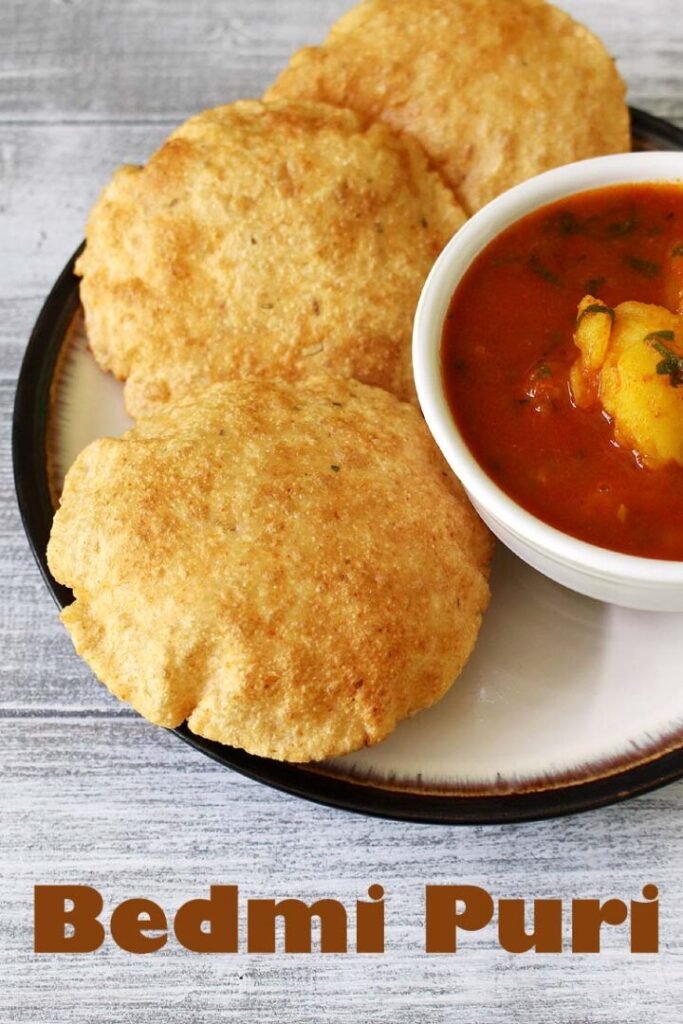
This savory puri is a staple breakfast or brunch item in North India, particularly in Delhi, Agra, Mathura, and Varanasi (Banaras), where it’s served by street vendors piping hot with served with a hearty portion of spicy rasedar aloo sabzi (a thin, tangy potato curry), this delightful pairing—popularly known as Bedmi Aloo—is a favorite for festive morning meals, weekend treats, and is often offered as prasad in temples.
Two Traditional Methods to Make Bedmi Puri:
- Pithi mixed into the dough (shared in this recipe): The soaked urad dal is ground into a coarse paste with minimal water and then mixed directly into the dough. This method is quick, simple, and ideal for home cooking.
- Stuffed Bedmi Puri: In this version, spiced urad dal paste is stuffed into dough like kachoris, making it a more elaborate Bedmi variation.
Texture and Taste:
Bedmi Puris stand out from regular puris with their thicker structure, crisp exterior, and richly spiced, slightly chewy interior that adds to their unique appeal. The addition of sooji (semolina) in the dough helps achieve that signature crispness. The puris are often spiced with a hint of dry masalas, which makes them tasty enough to enjoy even on their own.
Ingredients For Bedmi Puri:
- For the Pithi (Spiced Urad Dal Paste):
- ¼ cup urad dal (split and skinless black gram): Soak the dal in water for 3–4 hours or overnight until soft. Drain well and grind it into a slightly coarse paste without adding too much water. Urad dal is the heart of Bedmi Puri, adding both texture and depth of flavor.
- ½ teaspoon fennel seeds (saunf): Lends a gentle sweetness and aromatic undertone to balance the heat of the chilies and spices.
- ½ teaspoon cumin seeds (jeera): Adds a warm, earthy flavor to the dal paste, enhancing its savory profile.
- 1 green chili, finely chopped: Brings a fresh, spicy kick to the pithi. Adjust the amount according to your spice tolerance.
- For the Dough:
- 1½ cups whole wheat flour (atta): Acts as the foundation of the dough, giving the puris their structure while keeping the texture soft and pliable.
- 3 tablespoons sooji (rava or semolina): Added to give the puris a slight crunch and crisp texture, which sets Bedmi Puri apart from regular puris.
- Salt, to taste: Enhances the flavor of the dough and balances the spices from the pithi.
- 1 teaspoon red chili powder: Adds a hint of heat and a warm reddish tint to the dough for extra flavor.
- ¼ cup + 2 tablespoons water (approx.): Used to knead the dough. Add gradually to get a stiff yet pliable consistency suitable for rolling and frying.
Other Ingredients: Oil, for deep frying: Use any neutral-flavored oil. Heat it well before frying to ensure puffed, golden puris with a crisp outer layer.
Step-by-Step Instructions:
1) Rinse the urad dal under clean running water until the water turns clear. Alternatively, soak and swish it in a bowl, changing the water 3–4 times to get rid of dirt and residue. Then soak it in enough water for 3 to 4 hours to soften the dal.
2) After soaking, the dal will swell and almost double in volume. Drain all the water completely using a strainer, ensuring no excess moisture remains.
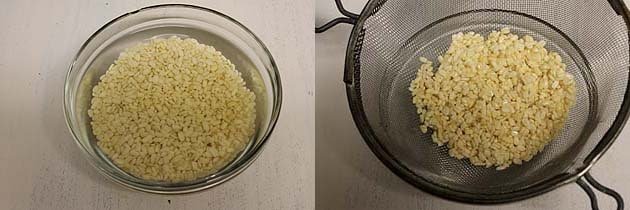
3) Transfer the soaked dal to a mixer or grinder jar. Add fennel seeds, cumin seeds, and chopped green chili to enhance the aroma and give a mild, spicy kick to the dal mixture.
4) Grind the mixture into a slightly coarse paste—not too smooth, and not overly grainy. This consistency is important: a very smooth paste can make the puris flat and chewy, while a very coarse one may cause them to break or not puff during frying.
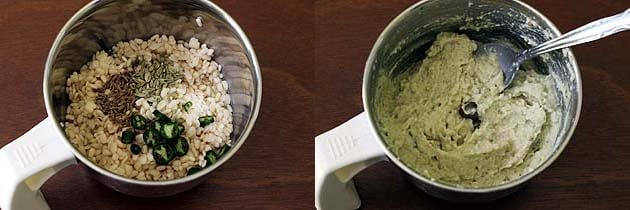
5) In a large mixing bowl, combine whole wheat flour (atta), sooji (semolina), salt, and red chili powder.
6) Mix the ground urad dal paste (pithi) into the flour blend, ensuring it’s evenly distributed for a well-balanced, flavorful dough.
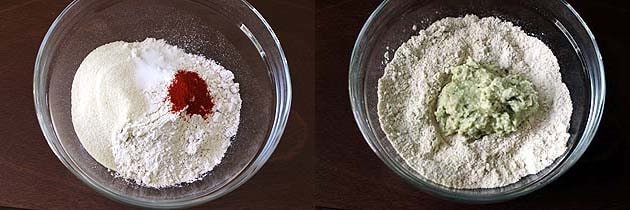
7) Using your fingertips, rub and mix the paste into the dry ingredients until it becomes crumbly and well combined.
8) Slowly pour in water, a small amount at a time, and knead the mixture into a firm yet smooth dough, much like regular poori dough. Once done, cover it with a cloth or lid and allow it to rest for 20 to 30 minutes so the gluten can develop.

9) After resting, knead the dough again for a minute or two to soften it further. Then divide the dough into 18 equal portions, shaping each into a smooth ball and flattening it slightly between your palms.
10) Take one dough ball and gently roll it into a round disc about 3½ inches in diameter. Prepare a few puris this way and place them on a plate, keeping them covered with a clean cloth to stop them from drying out.
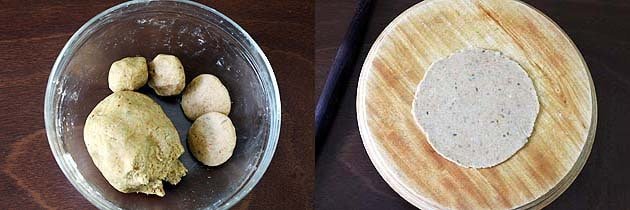
11) Heat oil in a heavy-bottomed kadhai or deep frying pan over medium-high heat. The oil needs to be hot enough for the puris to puff—check by dropping a small piece of dough; it should rise quickly.
12) Gently slide one puri into the hot oil. Use a slotted spoon to press it lightly in circular motions—this helps it puff up evenly.
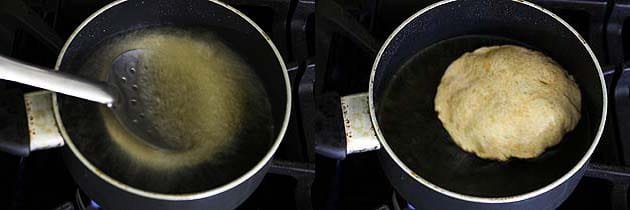
13) As the puri puffs and turns golden from the bottom, flip it to cook the other side until crisp and golden.
14) Once done, remove the puri using a slotted spoon and place it on a plate lined with paper towels to absorb excess oil. Repeat the same process with the remaining puris.
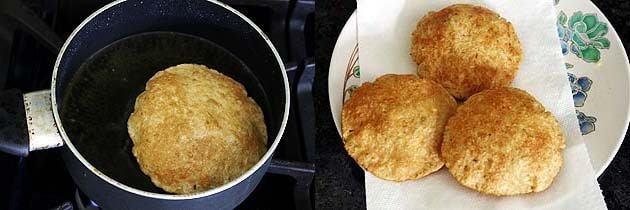
Expert Tips for Making Perfect Bedmi Puri
1. Soak the Dal Properly:
Be sure to soak the urad dal for a minimum of 3–4 hours or overnight. This allows the dal to soften properly, making it easier to grind into a paste and helping it combine smoothly with the flour for a consistent, well-textured dough.
2. Don’t Over-Grind the Dal:
Achieving the right texture depends largely on the consistency of the ground dal paste. Grind it coarsely—not too smooth, not too chunky. A very smooth paste can make puris dense and chewy, while an overly coarse one can cause tearing or poor puffing during frying.
3. Use Sooji for Crispiness:
Adding a few tablespoons of semolina (sooji/rava) to the dough gives the puris a lovely crispy outer layer that contrasts beautifully with the chewy inside.
It also ensures the puris remain crisp for a longer time after frying, enhancing their overall texture and appeal.
4. Adjust Water Carefully:
Since the dal paste has some moisture, add water little by little while kneading the dough. The goal is a firm, non-sticky dough that holds shape well when rolled.
5. Rest the Dough:
Allow the dough to rest for 20 to 30 minutes after kneading to improve texture and ease of rolling. Resting softens the dough, making it easier to roll. The rested dough also produces better puffed puris.
6. Roll Evenly:
Don’t roll too thin or too thick. Aim for medium thickness (around 3½ inches in diameter). Uneven rolling can result in uneven puffing or soggy spots.
7. Fry in Hot Oil:
Heat the oil well before frying. Drop a dough speck; if it sizzles and floats, the oil’s hot. Fry puris singly, pressing lightly to puff.
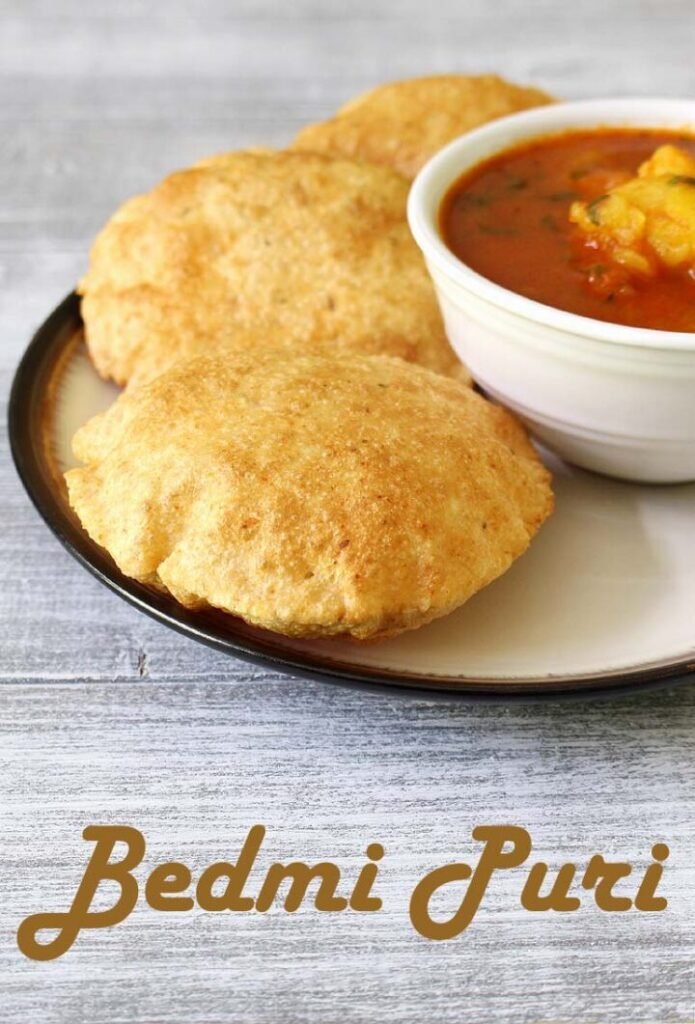
Serving Suggestions:
1. Bedmi Puri with Rasedar Aloo Sabzi:
The most traditional and beloved way to enjoy Bedmi Puri is with a hot and tangy rasedar aloo sabzi—a thin, spiced potato curry. This hearty pairing is a classic in Uttar Pradesh, especially in cities like Mathura, Agra, and Varanasi, where it’s a regular feature at roadside stalls and temple kitchens. The soft, spicy aloo sabzi balances the crisp puris perfectly and creates an irresistible meal.
2. Complement with Side Dishes:
Elevate the plate by adding sides such as boondi raita to cool the heat, or a refreshing kachumber salad made with cucumber, tomato, and onions. A spoonful of tamarind chutney adds tang, while a bit of achar (Indian pickle) brings in a sharp, salty-sour contrast that cuts through the richness of the fried puris. These accompaniments boost the overall taste while adding a mix of textures to the meal.
3. Ideal for Festive Feasts or Weekend Brunches:
Because this dish has no onion, no garlic, it is perfect for religious days, puja offerings, or as a sattvic meal during festivals like Navratri. It’s equally great as a weekend brunch treat when you’re in the mood for something hearty, spicy, and satisfying.
4. Pair with Traditional Beverages:
To complete the experience, serve your Bedmi Puri meal with a glass of sweet lassi, a cup of strong masala chai, or a chilled chaach (buttermilk spiced with cumin and herbs). These drinks help balance the spices and offer a refreshing finish to the meal.
